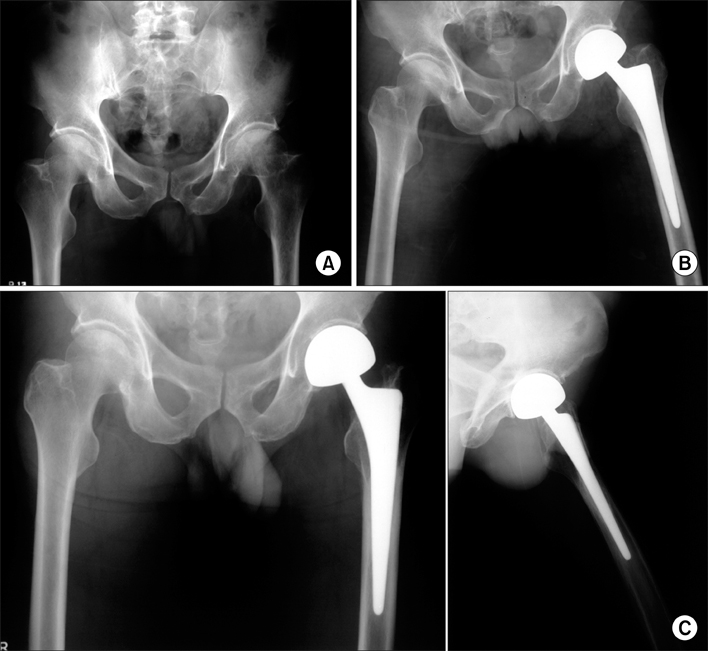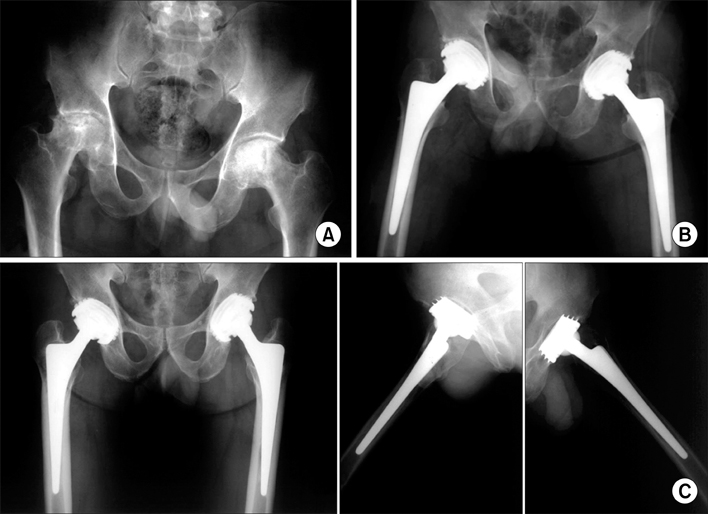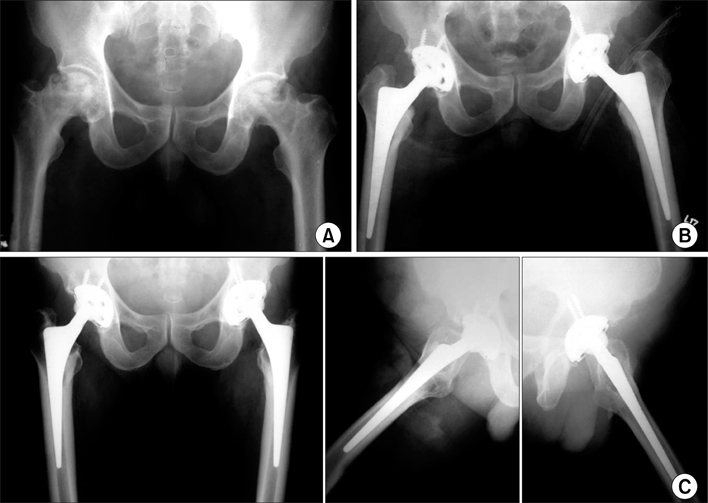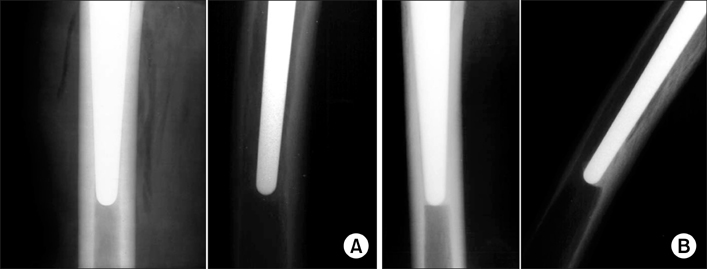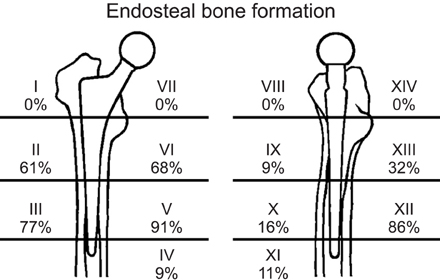J Korean Orthop Assoc.
2008 Dec;43(6):710-717.
Long-term Follow-up Results after Hip Arthroplasty using a Cementless Spotorno (CLS) Femoral Stem
- Affiliations
-
- 1Department of Orthopedic Surgery, National Medical Center, Seoul, Korea. drjmlee@paran.com
Abstract
-
PURPOSE: The purpose of this study was to evaluate the long-term clinical and radiological findings in patients who underwent total hip arthroplasty using a CLS femoral stem.
MATERIALS AND METHODS
We evaluated 40 patients (47 hips) who underwent total hip arthroplasty using a CLS femoral stem between 1988 and 1992. The average patient age at the time of operation was 45.3 years, and the average duration of follow-up was 17 years 3 months (range, 15 years to 19 years 10 months).
RESULTS
No femoral stem revisions were performed. The average Harris hip score improved from 51.9 preoperatively to 94.9 at final follow-up. Radiographically, small osteolytic lesions were found in 17 cases (36.2%), and endosteal bone formations were found in 44 cases (93.6%). Acetabular cup loosening occurred in 3 cases, and acetabular cup revisions were performed. Additionally, a liner change was performed in 1 case. One periprosthetic fracture and one dislocation were noted.
CONCLUSION
Fifteen-to-twenty-year follow-up results after total hip arthroplasty using a CLS femoral stem were excellent, with no patients requiring femoral stem revision.
Keyword
Figure
Reference
-
1. Aldinger PR, Breusch SJ, Lukoschek M, Mau H, Ewerbeck V, Thomsen M. A ten- to 15-year follow-up of the cementless spotorno stem. J Bone Joint Surg Br. 2003. 85:209–213.
Article2. Aldinger PR, Thomsen M, Mau H, Ewerbeck V, Breusch SJ. Cementless Spotorno tapered titanium stems: excellent 10-15-year survival in 141 young patients. Acta Orthop. 2003. 74:253–258.3. Brooker AF, Bowermen JW, Robinson RA, Riley LH Jr. Ectopic ossification following total hip replacement. Incidence and a method of classification. J Bone Joint Surg Am. 1973. 55:1629–1632.4. Bourne RB, Rorabeck CH, Patterson JJ, Guerin J. Tapered titanium cementless total hip replacements: a 10- to 13-year follow-up study. Clin Orthop Relat Res. 2001. 393:112–120.5. Campbell AC, Rorabeck CH, Bourne RB, Chess D, Nott L. Thigh pain after cementless hip arthroplasty. J Bone Joint Surg Br. 1992. 74:63–66.6. D'Antonio JA, Capello WN, Manley MT, Geesink R. Hydroxyapatite femoral stems for total hip arthroplasty: 10- to 13-year follow up. Clin Orthop Relat Res. 2001. 393:101–111.7. Engh CA, Bobyn JD, Glassman AH. Porous-coated hip replacement. The factors governing bone ingrowth, stress shielding and clinical results. J Bone Joint Surg Br. 1987. 69:45–55.
Article8. Engh CA Jr, Claus AM, Hopper RH Jr, Engh CA. Long-term results using the anatomic medullary locking hip prosthesis. Clin Orthop Relat Res. 2001. 393:137–146.
Article9. Engh CA, Masstin P, Suthers KE. Roentgenographic assessment of the biologic fixation of porous-surfaced femoral components. Clin Orthop Relat Res. 1990. 257:107–128.
Article10. Goldberg VM, Stevenson S, Feighan J, Davy D. Biology of grit-blasted titanium alloy implants. Clin Orhop Relat Res. 1995. 319:122–129.
Article11. Green JR, Nemzek JA, Arnoczky SP, Johnson LL, Balas MS. The effect of bone compaction of early fixation of porous-coated implants. J Arthroplasty. 1999. 14:91–97.12. Gruen TA, McNeice GM, Amstutz HC. "Mode of failure" of cemented stem-type femoral components: a radiographic analysis of loosening. Clin Orthop Relat Res. 1979. 141:17–27.13. Grübl A, Chiari C, Gruber M, Kaider A, Gottsauner-Wolf F. Cementless total hip arthroplasty with a tapered, rectangular titanium stem and a threaded cup: a minimum ten-year follow-up. J Bone Joint Surg Am. 2002. 84:425–431.14. Kim YH, Kim JS, Cho SH. Primary total hip arthroplasty with a cementless porous-coated anatomic total hip prosthesis: 10- to 12-year results of prospective and consecutive series. J Arthroplasty. 1999. 14:538–548.15. Lee JM, Lee CW. Comparison of hydroxyapatite-coated and non-hydroxyapatite-coated noncemented total hip arthroplasty in same patients. J Arthroplasty. 2007. 22:1019–1023.
Article16. Lee JM, Salvati EA, Betts F, DiCarlo EF, Doty SB, Bullough PG. Size of metallic and polyethylene debris particles in failed cemented total hip replacements. J Bone Joint Surg Br. 1992. 74:380–384.
Article17. Lester DK, Campbell P. 100 year old patient with pres-fit prosthesis: a postmortem retrieval study. Am J Orthop. 1995. 319:122–129.18. Mallory TH, Lombardi AV Jr, Leith JR, et al. Minimal 10-year results of tapered cementless femoral component in total hip arthroplasty. J Athroplasty. 2001. 16:8 Suppl 1. S49–S54.19. McNally SA, Shepperd JA, Mann CV, Walczak JP. The results at nine to twelve years of the use of a hydroxyapatite-coated femoral stem. J Bone Joint Surg Br. 2000. 82:378–382.
Article20. Mulliken BD, Bourne RB, Rorabeck CH, Nayak N. A tapered titanium femoral stem inserted without cement in a total hip arthroplasty. Radiographic evaluation and stability. J Bone Joint Surg Am. 1996. 78:1214–1225.
Article21. Murray DW, Carr AJ, Bulstrode CJ. Which primary total hip replacement? J Bone Joint Surg Br. 1995. 77:520–527.
Article22. Schramm M, Keck F, Hohmann D, Pitto RP. Total hip arthroplasty using an uncemented femoral component with taper design: outcome at 10-year follow-up. Arch Orthop Trauma Surg. 2000. 120:407–412.
Article23. Schreiner U, Scheller G, Herbig J, Jani L. Mid-term results of the cementless CLS stem. A 7- to 11-year follow-up study. Arch Orthop Trauma Surg. 2001. 121:321–324.24. Siebold R, Scheller G, Schreiner U, Jani L. Long-term results with the cement-free Spotorno CLS shaft. Orthopade. 2001. 30:317–322.25. Stauffer RN. Ten-year follow-up study of total hip replacement. J Bone Joint Surg Am. 1982. 64:983–990.
Article26. Sutherland CJ, Wilde AH, Borden LS, Marks KE. A ten-year follow-up of one hundred consecutive Mūller curved-stem total hip replacement arthroplasties. J Bone Joint Surg Am. 1982. 64:970–982.27. Vidyadhara S, Rao SK. Uncemented primary press-fit total hip arthroplasty: 3 to 6 years of experience. J Orthop Surg (Hong Kong). 2007. 15:50–55.28. Xenakis TA, Gelalis J, Koukoubis TA, Zaharis KC, Soucacos PN. Cementless hip arthroplasty in the treatment of patients with femoral head necrosis. Clin Orthop Relat Res. 2001. 386:93–99.
Article
- Full Text Links
- Actions
-
Cited
- CITED
-
- Close
- Share
- Similar articles
-
- 10-15 Year Follow-up Results of Total Hip Arthroplasty Using a CLS (Cementless Spotorno) Stem for Osteonecrosis of the Femoral Head
- Follow-Up Results of Total Hip Arthroplasty Using a Cementless Spotorno Stem for Osteonecrosis of the Femoral Head
- Radiological Analysis of the Tapered Femoral Stem after Cementless Hip Arthroplasty: Minimum 5 years follow-up
- Short Term Results of Cementless Total Hip Arthroplasty With a Tapered Femoral Component
- Cementless Total Hip Arthroplasty in Long Term Steroid-Induced Avascular Necrosis of the Hip

